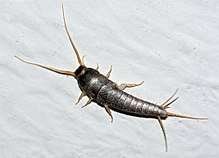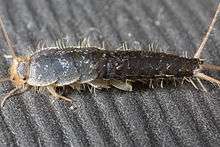Silverfish
A silverfish (Lepisma saccharina) is a small, primitive, wingless insect in the order Zygentoma (formerly Thysanura). Its common name derives from the animal's silvery light grey colour, combined with the fish-like appearance of its movements. The scientific name (L. saccharina) indicates the silverfish's diet consists of carbohydrates such as sugar or starches.
| Lepisma saccharina | |
|---|---|
 | |
| Scientific classification | |
| Kingdom: | |
| Phylum: | |
| Subphylum: | |
| Class: | Insecta |
| Subclass: | Apterygota |
| Order: | Zygentoma |
| Family: | Lepismatidae |
| Genus: | Lepisma |
| Species: | L. saccharina |
| Binomial name | |
| Lepisma saccharina | |
Description
Silverfish are nocturnal insects typically 13–25 mm (0.5–1.0 in) long.[1] Their abdomens taper at the end, giving them a fish-like appearance.[2] The newly hatched are whitish, but develop a greyish hue and metallic shine as they get older.[3] They have two long cerci and one terminal filament at the tip of the abdomen between the cerci. They also have two small compound eyes, despite other members of Zygentoma being completely eyeless, such as the family Nicoletiidae.[2][4]
Like other species in Apterygota, silverfish are completely wingless.[2][5] They have long antennae, and move in a wiggling motion that resembles the movement of a fish.[6] This, coupled with their appearance and silvery scales, inspires their common name. Silverfish typically live for two to eight years.[3] Silverfish are agile runners and can outrun most of their predators (including wandering spiders and centipedes). However, such running is possible only on horizontal surfaces, as they lack any additional appendages, and therefore are not fast enough to climb walls at the same speed. They also avoid light.[7]
Distribution
Silverfish are a cosmopolitan species, found in Africa, the Americas, Australia, Eurasia, and other parts of the Pacific.[8] They inhabit moist areas, requiring a relative humidity between 75% and 95%.[9] In urban areas, they can be found in attics, basements, bathtubs, sinks, kitchens, old books, classrooms, and showers.[3]
Reproduction and life cycle

Before silverfish reproduce, they carry out a ritual involving three phases, which may last over half an hour. In the first phase, the male and female stand face to face, their quivering antennae touching, then repeatedly back off and return to this position. In the second phase, the male runs away and the female chases him. In the third phase, the male and female stand side by side and head to tail, with the male vibrating his tail against the female.[10] Finally, the male lays a spermatophore, a sperm capsule covered in gossamer, which the female takes into her body via her ovipositor to fertilize her eggs. The female lays groups of fewer than 60 eggs at once, deposited in small crevices.[11] The eggs are oval-shaped, whitish, about 0.8 mm (0.031 in) long,[12] and take between two weeks and two months to hatch. A silverfish usually lays fewer than 100 eggs in her lifetime.[1]
When the nymphs hatch, they are whitish in colour, and look like smaller adults. As they moult, young silverfish develop a greyish appearance and a metallic shine, eventually becoming adults after three months to three years.[11] They may go through 17 to 66 moults in their lifetimes, sometimes 30 in a single year—many more than most insects. Silverfish are among the few types of insect that continue to moult after reaching adulthood.[13]
Ecology

Silverfish consume matter that contains polysaccharides, such as starches and dextrin in adhesives.[3] These include book bindings, carpet, clothing, coffee, dandruff, glue, hair, some paints, paper, photos, plaster, and sugar. They will damage wallpaper in order to consume the paste.[14] Silverfish can also cause damage to tapestries. Other substances they may eat include cotton, dead insects, linen, silk, leftover crumbs, or even their own exuvia (moulted exoskeleton). During famine, a silverfish may even consume leatherware and synthetic fabrics. Silverfish can live for a year or more without eating if water is available.[1][3][15]
Silverfish are considered household pests, due to their consumption and destruction of property.[1] However, although they are responsible for the contamination of food and other types of damage, they do not transmit disease.[3][16] Earwigs, house centipedes, and spiders are known to be predators of silverfish.[17][18]
Etymology
The scientific name for the species is Lepisma saccharina, due to its tendency to eat starchy foods high in carbohydrates and protein, such as dextrin.[3] However, the insect's more common name comes from its distinctive metallic appearance and fish-like shape.[19] While the scientific name was established by Carl Linnaeus in his 1758 10th edition of Systema Naturae, the common name has been in use since at least 1855.[20][21]
Evolution
Together with jumping bristletails, the predecessors of silverfish are considered the earliest, most primitive insects. They evolved at the latest in mid-Devonian and possibly as early as late Silurian more than 400 million years ago.[22] Some fossilized arthropod trackways from the Paleozoic Era, known as Stiaria intermedia and often attributed to jumping bristletails, may have been produced by silverfish.[23]
Similar species

Other similar insect species are also known as silverfish. Two other silverfish are common in North America, Ctenolepisma longicaudata and Ctenolepisma quadriseriata.[11] Ctenolepisma urbana is known as the urban silverfish.[8] The Australian species most commonly referred to as silverfish is a different lepismatid, Acrotelsella devriesiana.[2] The firebrat (Thermobia domestica) is like a silverfish, but with a mottled gray and brown body.[24]
References
- Day, Eric (August 1996). "Silverfish factsheet, Department of Entomology". Virginia Cooperative Extension. Virginia Polytechnic Institute and State University, Virginia State University. Retrieved 2008-12-25.
- "Thysanura – silverfish". CSIRO Entomology. Australia. Retrieved 2009-11-20.
- Jackman (1981). "Silverfish". AgriLife Extension. Archived from the original on 2009-12-12. Retrieved 2009-11-20.
- "Thysanura Families". CSIRO Entomology. Australia. Retrieved 2009-11-20.
- Hoell, H. V., Doyen, J. T. & Purcell, A. H. (1998). Introduction to Insect Biology and Diversity, 2nd ed. Oxford University Press. pp. 333–340. ISBN 0-19-510033-6.CS1 maint: multiple names: authors list (link)
- "Silverfish and Firebrats". Iowa Insect Information Notes. Iowa State University. 2005-07-14. Retrieved 2009-11-26.
- "Silverfish – Pest Control Infestation.ca".
- Yates, Julian R. III (December 1992). "Silverfish". University of Hawaii. Retrieved 2009-11-27.
- Barnes, Jeffrey K. (October 6, 2005). "Silverfish". Arthropod Museum Notes. University of Arkansas. Retrieved 2008-12-25.
- Von H. Sturm (1965). "Die Paarung beim Silberfischchen, Lepisma saccharina". In Zeitschrift fur Tierpsychologie, Band 13, Heft 1.
- Houseman, Richard (August 2007). "Silverfish and Firebrats". University of Missouri Extension. Retrieved 2009-11-24.
- Koehler, P. G.; Branscome, D.; Oi, F. M. "Booklice and Silverfish". Electronic Data Information Source. University of Florida. Retrieved 2009-11-27.
- Hubbell, Sue (1993). Broadsides from the Other Orders: A book of bugs. ISBN 0-679-40062-1.
- "How to control silverfish". Pest Control Direct. Retrieved 3 September 2016.
- "Bristletails (Silverfish and Firebrats) (Department of Entomology)". Department of Entomology (Penn State University). Retrieved 2016-04-25.
- Hahn, Jeffrey; Kells, Stephen A. (2006). "Silverfish and Firebrats". University of Minnesota Extension. Retrieved 2009-11-27.
- Jacobs, Steve, Sr. (January 2006). "House Centipedes — Entomology — Penn State University". Pennsylvania State University. Retrieved 2009-11-23.
- Pehling, Dave (November 2007). "Spiders". Washington State University. Archived from the original on 2010-02-10. Retrieved 2009-11-23.
- "Silverfish". Dictionary.com Unabridged. Retrieved 2009-11-20.
- Linnaeus, Carolus (1758). Systema Naturae. 1 (10th ed.). p. 608.
- Harper, Douglas (November 2001). "Silverfish". Online Etymology Dictionary. Retrieved 2009-11-20.
- Grimaldi, David; Engel, Michael S. (2005). Evolution of the Insects. Cambridge University Press. pp. 148–155. ISBN 0-521-82149-5.
- Getty, Patrick; Sproule; Wagner; Bush (2013). "Variation in Wingless Insect Trace Fossils: Insights from Neoichnology and the Pennsylvanian of Massachusetts". PALAIOS. 28: 243–258. doi:10.2110/palo.2012.p12-108r.
- "Silverfish and firebrats in homes : Insects : University of Minnesota Extension". www.extension.umn.edu. Retrieved 13 December 2017.
External links
| Wikimedia Commons has media related to Lepisma saccharina. |
| Look up silverfish in Wiktionary, the free dictionary. |
- Fact sheet on silverfish highlighting habits, habitat and threats
- Klass, Carolyn (1981). "Silverfish and Firebrats" (PDF). Insect Diagnostic Laboratory. Cornell University. Retrieved 2015-11-16.
- Museumpests.net Silverfish factsheet